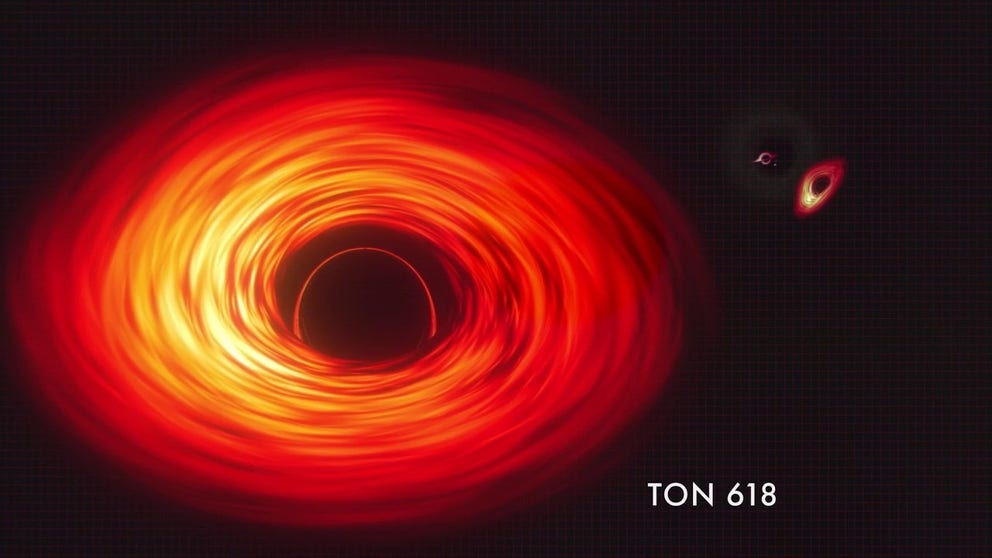Newly discovered black hole jets span more than 140 Milky Way galaxies long
Astronomers have nicknamed the jet megastructure Porphyrion, a giant in Greek mythology. Experts say the jet pair dates back to 6.3 billion years when the universe was half its current age and is outputting an equivalent to a trillion suns.
How big are supermassive black holes compared to Earth?
All monster black holes are not equal. Watch this video to see how they compare to each other and to our solar system. The black holes shown, which range from 100,000 to more than 60 billion times our Sun’s mass, are scaled according to the sizes of their shadows – a circular zone about twice the size of their event horizons. Only one of these colossal objects resides in our own galaxy, and it lies 26,000 light-years away. Smaller black holes are shown in bluish colors because their gas is expected to be hotter than that orbiting larger ones. Scientists think all of these objects shine most intensely in ultraviolet light.
Astronomers have discovered twin black hole jets that span a distance greater than 140 Milky Way galaxies long, the biggest jets found yet.
Unlike popular culture references, black holes don’t consume everything immediately. These powerful systems eject charged material faster than the speed of light before it falls back into the black hole, creating dueling jets blasting out from a supermassive black hole in both directions.
Astronomers, in a study published in the journal Nature, say they have found a pair of black hole jets using Europe’s Low-Frequency Array (LOFAR) radio telescope that is more gargantuan than previously known jet systems.

A photo of the heart of LOFAR (LOw Frequency ARray), which consists of tens of substations spread across Europe.
(ASTRON)
Study lead author Martijin Oei, with Caltech and Leiden Observatory in the Netherlands, said in a news release this jet pair would make our home galaxy of the Milky Way look like a "little dot in these two giant eruptions" because the jets span 23 million light-years, which is the equivalent of 140 million Milky Way galaxies lined up back-to-back.
Astronomers have nicknamed the jet megastructure Porphyrion, a giant in Greek mythology. Experts say the jet pair dates back to 6.3 billion years when the universe was half its current age. Porphyrion is outputting an equivalent to a trillion suns, shooting out energy above and below the supermassive black hole at the heart of the host galaxy.

This picture, taken by Europe's LOFAR (LOw Frequency ARray) radio telescope, shows the longest known pair of black hole jets. Nicknamed Porphyrion after a Greek giant by co-discoverer Aivin Gast of the University of Oxford, the jet system spans 23 million light-years, the equivalent of 140 Milky Way galaxies lined up back to back. The galaxy hosting the supermassive black hole, which is 7.5 billion light-years away, is a dot in the center of the image. The largest blob-like structure near the center is a separate smaller jet system. The relative size of our Milky Way galaxy is indicated in the lower, right corner.
The sky survey using LOFAR revealed 10,000 faint megestructures, according to the study.
"Up until now, these giant jet systems appeared to be a phenomenon of the recent universe," Oei said. "If distant jets like these can reach the scale of the cosmic web, then every place in the universe may have been affected by black hole activity at some point in cosmic time."
SUPERMASSIVE BLACK HOLES: JUST HOW BIG ARE THEY?
Using data from observatories in Hawaii, Arizona and India, the science team was able to pinpoint the source of the mega jets to a galaxy 7.5 billion light-years from Earth.
While Porphyrion is by far the largest twin jet discovered yet, researchers say it might not hold that title for long. The previous largest confirmed jet system, Alcyoneus, discovered in 2022, runs the equivalent of about 100 Milky Way galaxies.
"We may be looking at the tip of the iceberg," Oei said. "Our LOFAR survey only covered 15 percent of the sky. And most of these giant jets are likely difficult to spot, so we believe there are many more of these behemoths out there."
